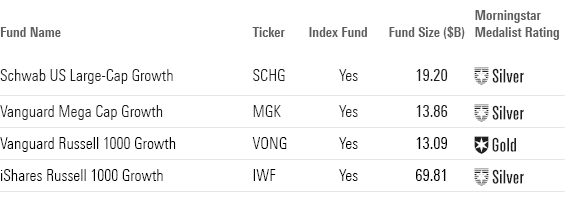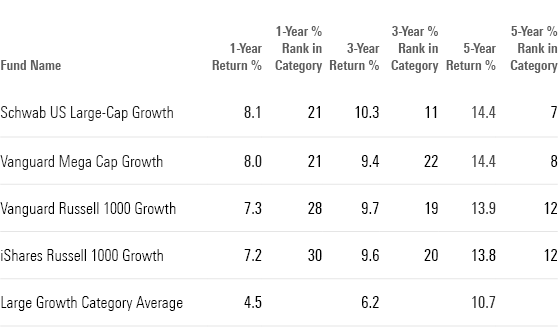4 Top-Performing Large-Growth ETFs
ETFs tilted toward technology stocks have led the category.

Recently in 2023, investors in large-growth stock exchange-traded funds, or ETFs, have seen an upswing in performance.
Large-growth ETFs have gained 23% this year through Aug. 15, while the overall market, as measured by the Morningstar US Market Index, has only gained 16.4%. Among the top-performing large-growth ETFs are those slightly tilted toward technology stocks compared to the category average—a stake that has been beneficial in early 2023 as the largest technology stocks led us into a new bull market.
Currently, offerings from Schwab, Vanguard, and iShares are among the top-performing large-growth ETFs.
What Are Large-Growth ETFs?
Stocks in the top 70% of the capitalization of the U.S. equity market are defined as large-cap. Large-growth portfolios focus on companies in rapidly expanding industries. Growth is defined based on fast growth (high growth rates for earnings, sales, book value, and cash flow) and high valuations (high price ratios and low dividend yields). Large-growth portfolios invest primarily in big U.S. companies that are projected to grow faster than other large-cap stocks.
Large Growth Funds vs U.S. Stock Market
4 Top-Performing Large-Growth ETFs
To screen for the best-performing ETFs in this Morningstar Category, we looked for the strategies that have posted top returns across multiple time periods.
We first screened for the ETFs that ranked in the top 33% of the category using their lowest-cost share classes over the past one-, three-, and five-year time frames. Then we filtered the list for ETFs with Morningstar Medalist Ratings of Gold, Silver, or Bronze for those classes. We also excluded funds with less than $100 million in assets and those with minimal or no Morningstar analyst input on their Medalist Ratings.
From this screen, we’ve highlighted the four ETFs with the best year-to-date performance. This group consists only of index funds, which mirror the market index’s portfolio.
Because the screen was created with the lowest-cost share class for each fund, some funds may be listed with share classes that are not accessible to individual investors outside of retirement plans. The individual investor versions of those funds may carry higher fees, which reduces returns to shareholders.
Top-Performing Large-Growth ETFs

Schwab US Large-Cap Growth ETF
- Ticker: SCHG
- Morningstar Medalist Rating: Silver
- Morningstar Rating: 5 stars
“The fund’s minuscule fee, broad representation of the available opportunity set, and low cash drag have provided it a competitive edge. The fund outperformed the category average by 2.75 percentage points annualized over the past 10 years through April 2023.
“The fund is always fully invested, while its actively managed peers can hold cash. This aids its performance during market rallies. However, being fully invested isn’t likely to translate into strong performance during downturns. The fund lagged its average peer by 1.61 percentage points in 2022 because it was overweight in tech stocks, which hurt its performance.
“But that higher tech allocation has been a boon so far in 2023. The fund eclipsed its average peer by 6.67 percentage points through the end of April as tech stocks rebounded.
“The fund’s sector allocations do not deviate by more than 4 percentage points except for its exposure to tech stocks, which was 9 percentage points higher than the category average as of April 2023. It made up some of the difference by underweighting industrial stocks by 3 percentage points.”
—Mo’ath Almahasneh, associate analyst
Vanguard Mega Cap Growth ETF
- Ticker: MGK
- Morningstar Medalist Rating: Silver
- Morningstar Rating: 4 stars
“The fund tracks the CRSP U.S. Mega Cap Growth Index, which captures the growth-oriented side of the mega-cap market. Growth stocks tend to have high valuations because of investor sentiment around their superior growth prospects. While growth stocks constitute much of the fund, value and blend stocks are also present, which should steady the fund when its growth holdings can’t meet their lofty expectations.
“Some of the fund’s peers include mid-cap stocks, but this fund excludes them. This has pushed its average market cap above $550 billion—$210 billion more than the category average as of May 2023. An emphasis on larger companies may hold it back when smaller stocks rally, but it should also partially insulate the portfolio when markets sour since mid-cap stocks can be more volatile.
“Performance has been strong since the fund started tracking its current index in April 2013. Through May 2023, it outperformed its average category peer by nearly 3 percentage points annually over that time. Volatility was higher owing to its concentrated portfolio, but not exceedingly so, allowing the fund to post a considerable risk-adjusted-return advantage.”
—Zachary Evens, associate analyst
Vanguard Russell 1000 Growth ETF
- Ticker: VONG
- Morningstar Medalist Rating: Gold
- Morningstar Rating: 5 stars
“It has provided better returns compared with peers, but similar returns compared with the category benchmark. This share class led its average peer by an annualized excess return of 3 percentage points over a 10-year period. And its return mirrored the performance of the category index, the Russell 1000 Growth Index, over the same period.
“This low-turnover portfolio is dominated by leading growth names with sound financial footing, imparting a slight quality tilt. Names like Apple AAPL, Microsoft MSFT, and Amazon.com AMZN make up the top spots in the portfolio. The fund’s profitability, proxied by its return on invested capital, has averaged 11% higher than its average peer over the trailing five years through April 2023.
“The fund holds names with slower growth outlooks that don’t qualify as value stocks. They can temper the fund’s growth exposure and provide a modest buffer when growth stocks underperform. Companies like UnitedHealth Group UNH and Home Depot HD fit this description.”
—Mo’ath Almahasneh
iShares Russell 1000 Growth ETF
- Ticker: IWF
- Morningstar Medalist Rating: Silver
- Morningstar Rating: 5 stars
“Over the past five years, the iShares Russell 1000 Growth ETF shares have returned an average of 14.3% per year, putting it in the 7th percentile of the category. For the last three years, the fund has returned an average of 11% a year, leading the fund to the 11th percentile among all large-growth ETFs. And for the past 12 months, the fund lands in the 19th percentile with a 10.9% gain.
“It outperformed its average peer by 2.64 percentage points annualized with similar volatility over the 10 years through April 2023. Its low fees should help it continue that outperformance over the long run.
“Its higher-than-average stake in technology stocks was a boon in early 2023. The fund eclipsed its average peer by 3.04 percentage points through the end of April as technology stocks rebounded.
“Most of the fund’s sector exposures have hewed close to its average peer. The fund’s sector allocations do not deviate by more than 4 percentage points, except for its exposure to technology stocks, which are 6.5 percentage points higher than that of its average category peer as of April 2023. It made up some of the difference by underweighting financial and healthcare stocks by 3 percentage points.”
—Mo’ath Almahasneh
Long-Term Returns of Top-Performing Large-Growth ETF

The author or authors do not own shares in any securities mentioned in this article. Find out about Morningstar’s editorial policies.

/s3.amazonaws.com/arc-authors/morningstar/4513c31c-df10-4538-9285-4707e579cd32.jpg)
/cloudfront-us-east-1.images.arcpublishing.com/morningstar/VUWQI723Q5E43P5QRTRHGLJ7TI.png)
/cloudfront-us-east-1.images.arcpublishing.com/morningstar/XLSY65MOPVF3FIKU6E2FHF4GXE.png)
/cloudfront-us-east-1.images.arcpublishing.com/morningstar/F2S5UYTO5JG4FOO3S7LPAAIGO4.jpg)
:quality(80)/s3.amazonaws.com/arc-authors/morningstar/4513c31c-df10-4538-9285-4707e579cd32.jpg)